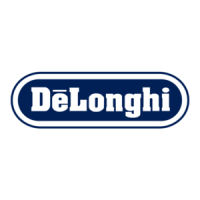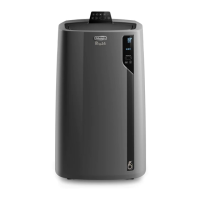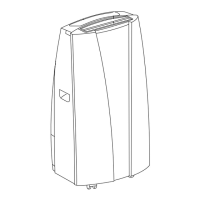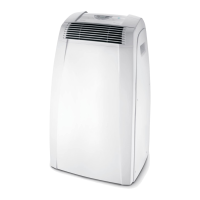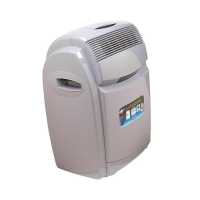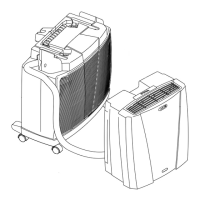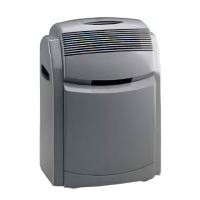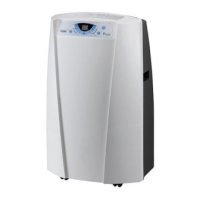12
INTRODUCTION
Thank you for choosing a De’Longhi product. Please take a few
moments to read the instructions to avoid risks or damage to the
appliance.
DESCRIPTION
Description of the appliance (see page 2- A)
A1 air outlet ap
A2 control panel
A3 handles
A4 castors
A5 silver ions lter
A6 air intake grille
A7 air exhaust hose housing
A8 air intake grille
A9 power cable
A10 drainage hose with cap
A11 remote control signal receiver
A12 remote control compartment
Description of the accessories (see page 2 - B)
B1 wall ange with cap
B2 air exhaust hose
B3 hose adaptor
B4 adapter for window bracket
B5 window bracket with wing nut
B6 adapter for wall mounting/window outlet
B7 window outlet
B8 remote control
B9 window bracket cap
ELECTRICAL CONNECTION
Before plugging into the mains, check the following:
• the mains voltage is the same as that indicated on the plate
on the back of the appliance;
• the socket and electrical line are sized to support the load
required;
• the socket is the proper type for the plug, otherwise, re-
place the socket;
• the socket is connected to an ecient earthing system.
The manufacturer is not responsible in the event of non-
compliance with these injury prevention standards.
The power cable must only be replaced by specialised
technicians.
USE
The instructions below will enable you to prepare your air con-
ditioner for operation as eciently as possible. Before use, make
sure the air intake and outlet grilles are unobstructed.
Please note: This appliance is provided with an auto-evapora-
tion feature for condensate removal during cooling and dehu-
midifying modes.
AIR CONDITIONING WITHOUT INSTALLATION
CASEMENT WINDOW
If you have a casement window proceed as follows:
• Fit the air exhaust hose (B2) in the relevant housing located
on the rear side of the appliance (g. 1).
• Screw the window outlet (B7) and place outside the win-
dow to exhaust the hot air (g. 2).
DOUBLEHUNG WINDOW
If you have a double-hung window proceed as follows:
• Insert and lock the adapter for window bracket (B4) into
the slot of the window bracket (B5) (g.3)
• Place the window bracket in the window sill, and extend
the bracket fully within the window frame (g. 4).
• Fix the bracket by the wing nut (g. 5) (Should the window
bracket be too large for the window the plastic can be cut
with a saw by a qualied professional).
• Insert the air exhaust hose (B2) into the adapter for win-
dow bracket (B4) and rotate it as shown in g. 6.
• In order to facilitate the tting of the air exhaust hose (B2)
in the relevant housing located on the rear side of the ap-
pliance, position the hose adapter ‘s tabs (B3) in a vertical
axis as shown in g. 7 and proceed as shown in g.1.
SLIDING WINDOWS
• Thanks to the locking wing nut, it’s possible to use the win-
dow bracket also for sliding windows. Position the bracket
vetically with the hole in the lower part so to allow a easier
installation of the exhaust hose.
AIR CONDITIONING WITH INSTALLATION
• Fit the air exhaust hose (B2) in the relevant housing located
on the rear side of the appliance (g. 1).
• Drill a hole 150 mm in an outside wall or through a window
panel. Respect the distances, dimensions and heigh of the
hole given in gure 8.
